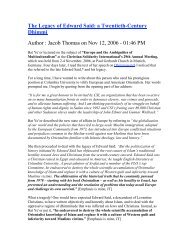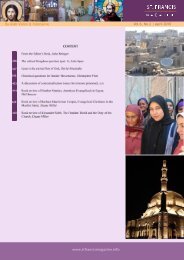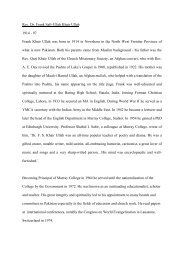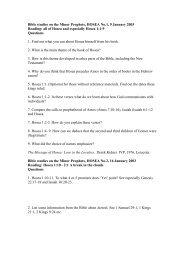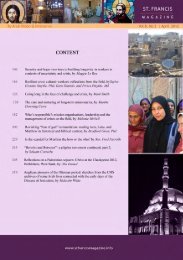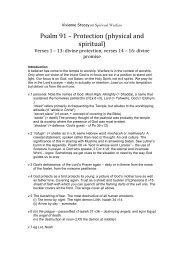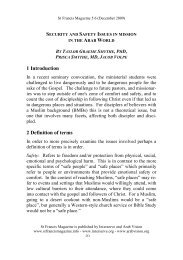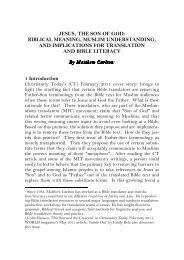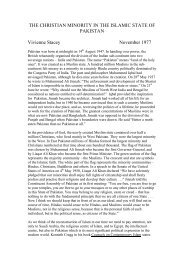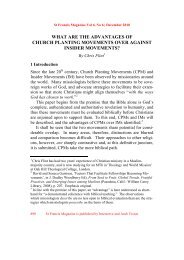download the pdf - St.Francis Magazine
download the pdf - St.Francis Magazine
download the pdf - St.Francis Magazine
You also want an ePaper? Increase the reach of your titles
YUMPU automatically turns print PDFs into web optimized ePapers that Google loves.
<strong>St</strong> <strong>Francis</strong> <strong>Magazine</strong> Vol 8, No 4 | August 2012<br />
2 Corinthians 6:14-7:1 as clearly supporting a more extractionist<br />
stance towards <strong>the</strong> believers’ setting, and Parshall (2004: 288) noted<br />
that both C4 and C5 arguments appealed to 1 Corinthians 9:19-22,<br />
suggesting that it was not a decisive text for a C5 stance. Such appeals<br />
in defence of C5 were opposed by Waterman (2007: 61) on <strong>the</strong><br />
grounds that being ‘under Christ’s law’ (v.23) negates <strong>the</strong> C5 claim<br />
and that <strong>the</strong>re is “a major difference between becoming like a group<br />
and becoming fully part of that group.”<br />
1 Corinthians 7:20 is <strong>the</strong> o<strong>the</strong>r major text in 1 Corinthians to<br />
which C5 advocates make appeal, such that Parshall (2004: 288)<br />
called it “<strong>the</strong> new hermeneutic on <strong>the</strong> block.” Thus Talman (2004:<br />
8) cited vv.20 and 24 as supporting continuing identification with<br />
wider culture. Taking this fur<strong>the</strong>r, Lewis (2004b:146-147) proposed<br />
that “women win people to Christ by marrying non-Christians,” citing<br />
1 Corinthians 7:13-14 and 1 Peter 3:1-2 in defence of her claim.<br />
Lewis (2007: 76) fur<strong>the</strong>r appealed to 1 Corinthians 7:17-24 as indicating<br />
<strong>the</strong> gospel’s appeal to whole networks, even whole towns,<br />
within an alternative and avowedly non-extractionistoikos model for<br />
church (for a summary and critical assessment of which, see Wolfe<br />
2011: 40-49).<br />
With regard to such appeals to 1 Corinthians 7, Woods (2003)<br />
saw instances of C5 eisogesis, and Tennent (2006: 107) understood<br />
<strong>the</strong> passage as opposing <strong>the</strong> use of <strong>the</strong> old proselyte model of conversion<br />
and, as such, is opposed to <strong>the</strong> C5 project. Smith (2009: 25)<br />
claimed that 1 Corinthians 6:14-18 supported extraction for <strong>the</strong> sake<br />
of Christ, and saw C5 appeals to 1 Corinthians 7:17-24 as problematic<br />
because “Islam is both a religion and a culture.” Such a conclusion<br />
sits entirely counter to <strong>the</strong> differentiation of religion and culture<br />
made by Lewis in Brogden (2010: 34). For Dixon (2009: 18) 1<br />
Corinthians 7:24 had achieved <strong>the</strong> status of being a C5 proof text,<br />
and for Span (2009a: 46) 1 Corinthians 4:13 taught <strong>the</strong> believer’s<br />
position was, instead, that of becoming <strong>the</strong> scum of <strong>the</strong> earth. Clearly<br />
<strong>the</strong> ‘new hermeneutic’ is far from consensual.<br />
O<strong>the</strong>r texts in 1 Corinthians have also been claimed in support of<br />
C5. 1 Corinthians 8:10 has been suggested as possibly allowing ‘insider’<br />
eating (Higgins 2007: 37). Likewise, 1 Corinthians 10:23-33<br />
<strong>St</strong> <strong>Francis</strong> <strong>Magazine</strong> is a publication of Interserve and Arab Vision 470




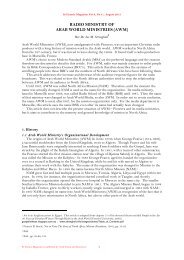
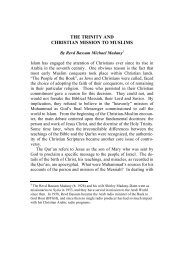
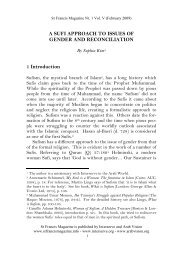
![Reflections on Surah Fatiha and the Lord's Prayer[1] - St.Francis ...](https://img.yumpu.com/49377951/1/184x260/reflections-on-surah-fatiha-and-the-lords-prayer1-stfrancis-.jpg?quality=85)
